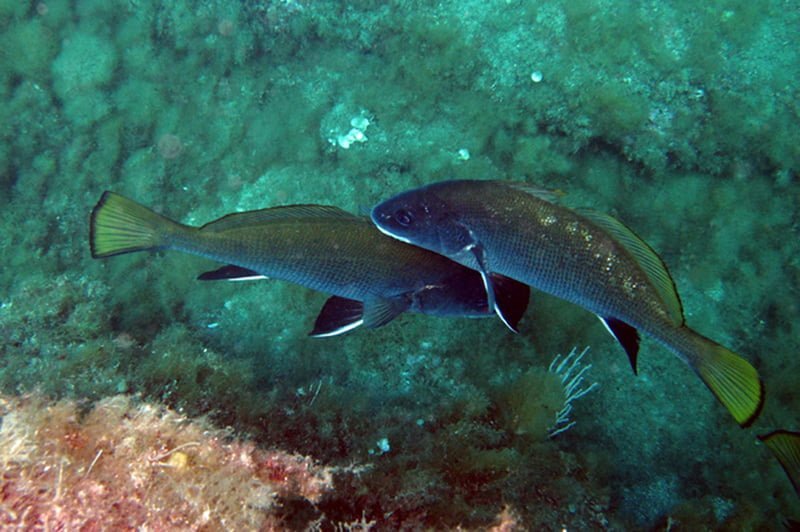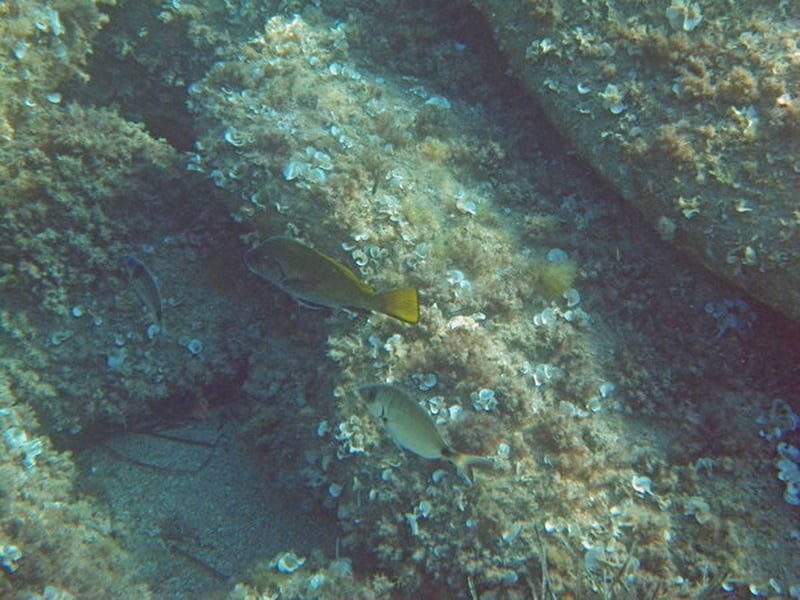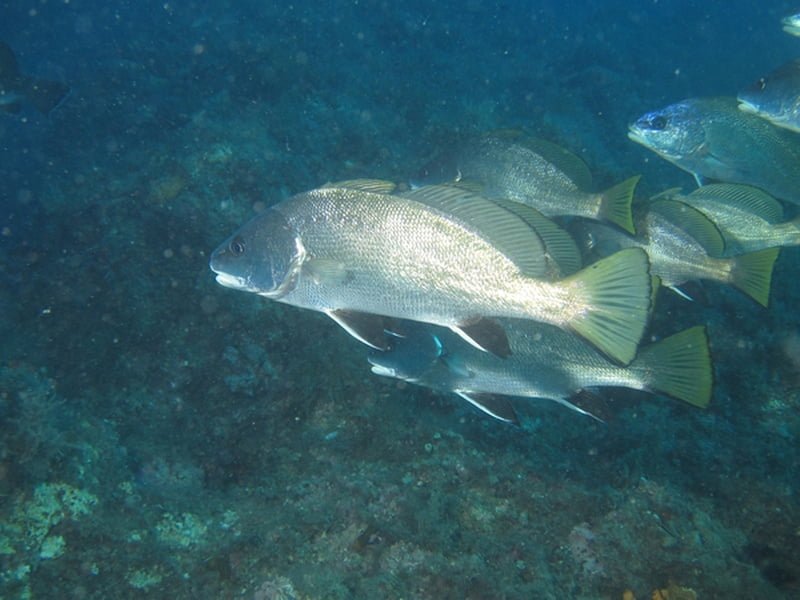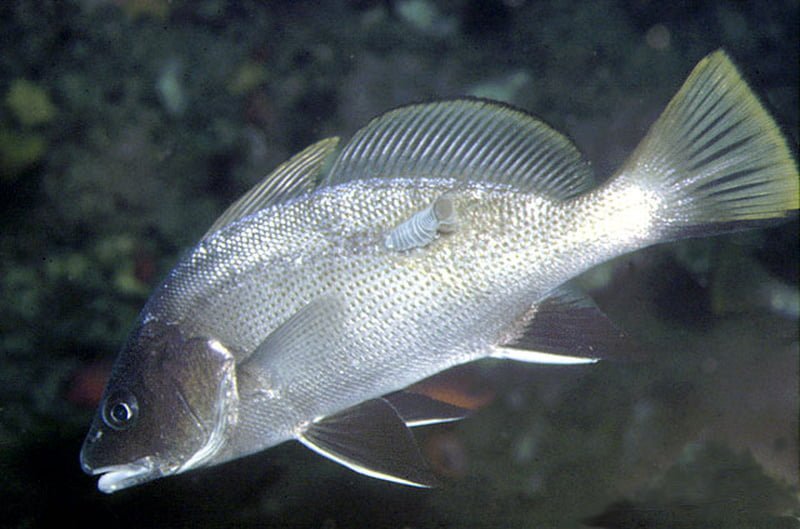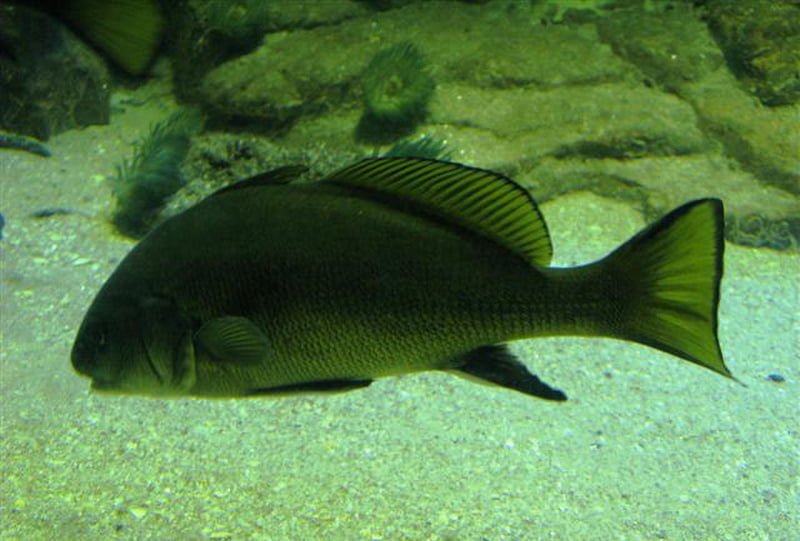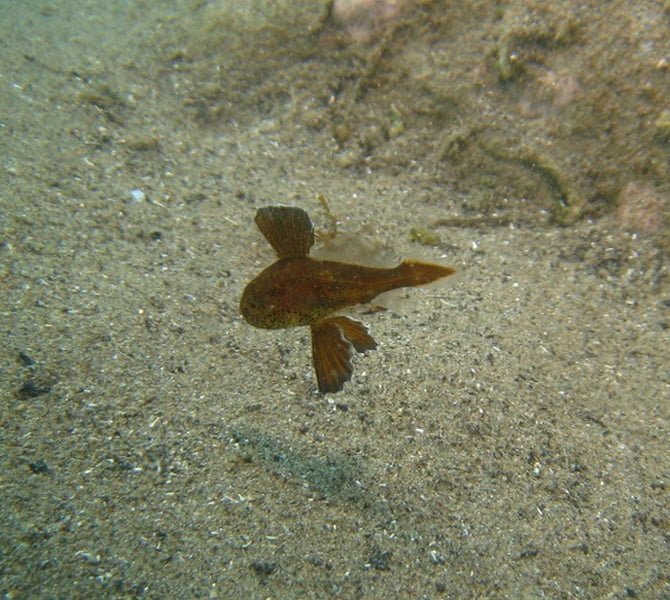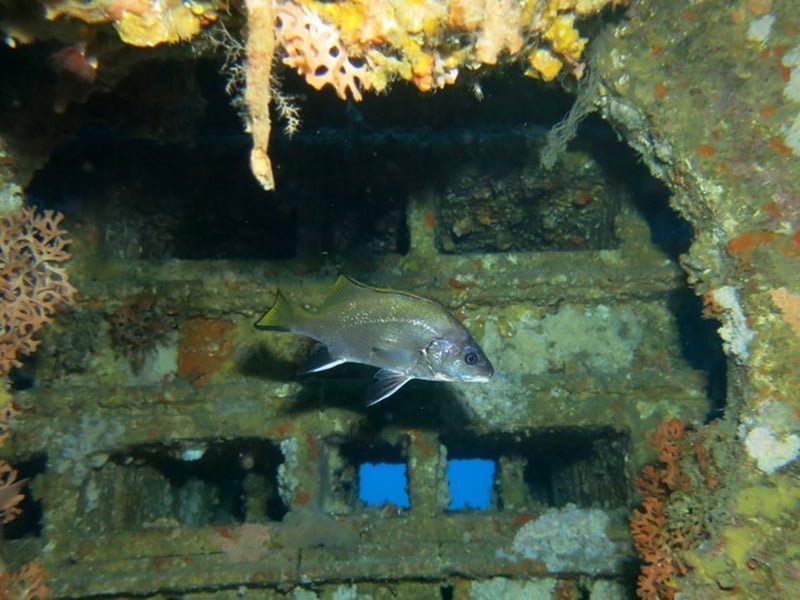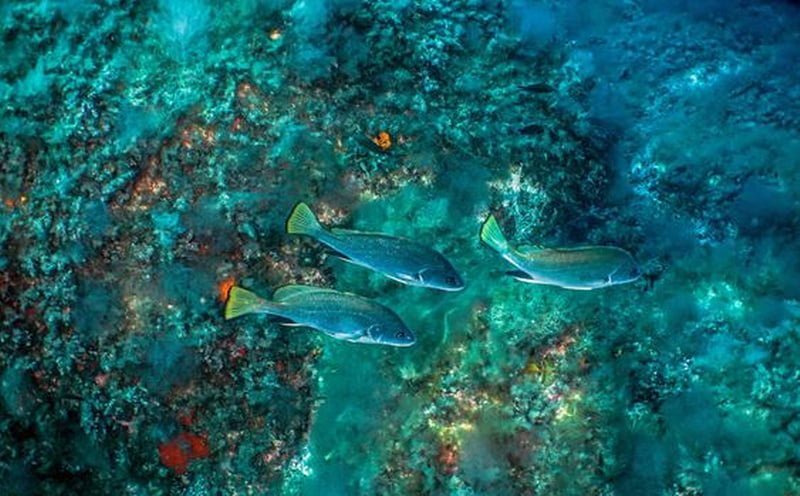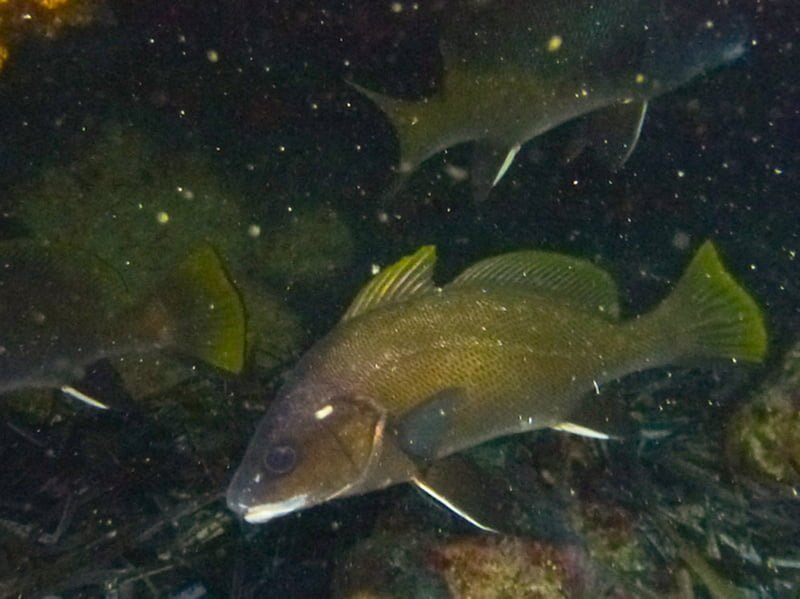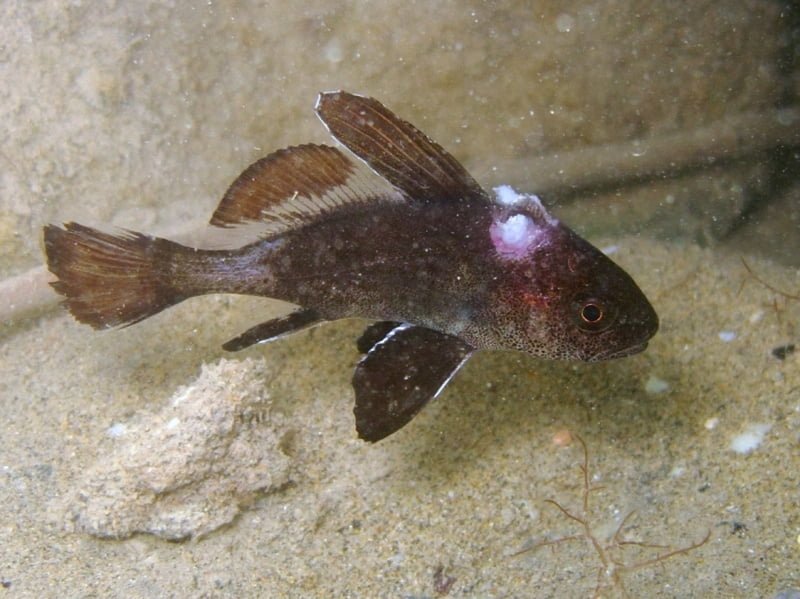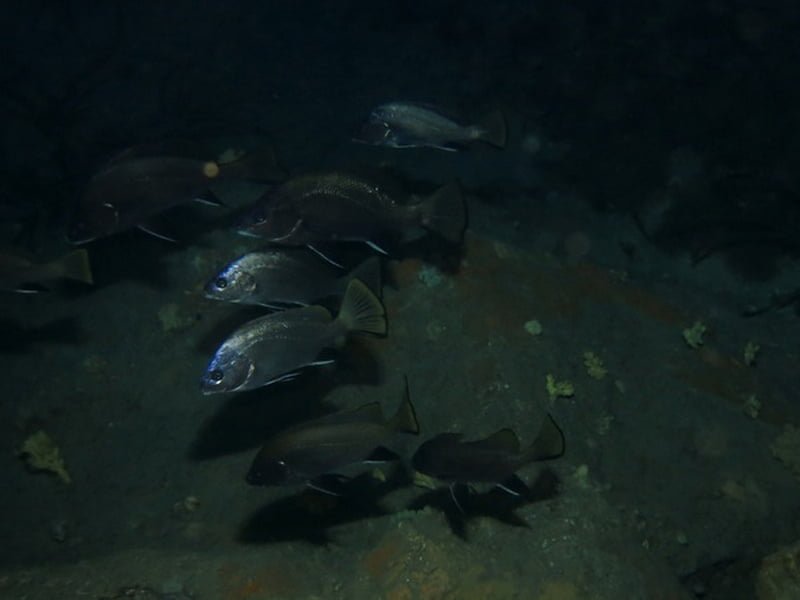Sciaena Umbra
– Brown Meagre – Common Corb –
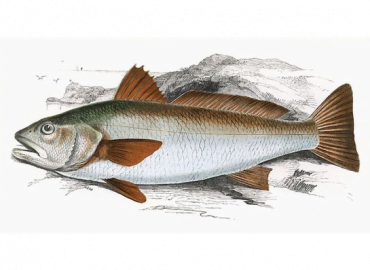
| Conservation status |
|---|
 Near Threatened (IUCN 3.1)[1] |
| Scientific classification |
Sciaena umbra
Linnaeus, 1758[2]
| Kingdom: | Animalia |
| Phylum: | Chordata |
| Class: | Actinopterygii |
| Order: | Perciformes |
| Family: | Sciaenidae |
| Genus: | Sciaena |
| Species: | S. umbra |
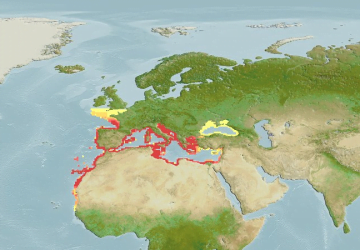
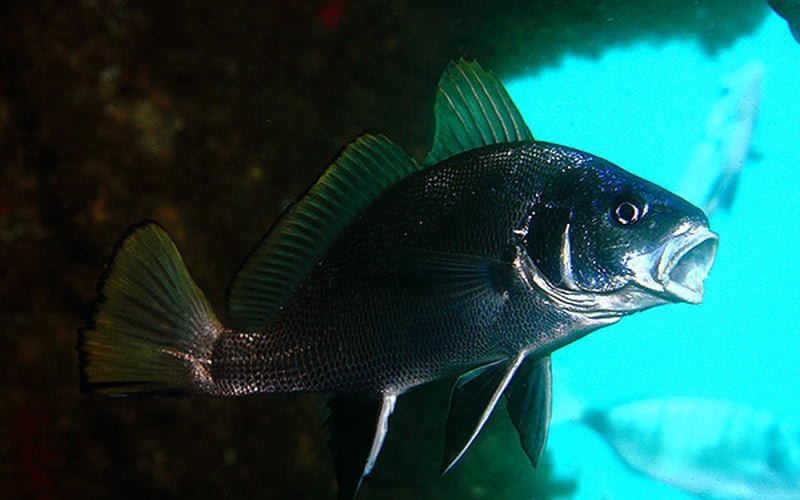
Brown meagre or corb (Sciaena umbra) is a species of croaker found in, the eastern Atlantic, Mediterranean Sea and Black Sea occurring in shallow waters and sandy bottoms. It is harvested for human consumption, especially in the Mediterranean.
Description
The brown meagre is between 30 and 40 cm in length but can grow to 60 cm. It has a flat belly and its strongly arched back which give it an easily recognisable shape, the body is laterally compressed and the large, horizontal mouth reaches the level of the eye and contains villiform teeth. The anal and pelvic fins are black with an anterior white border. Both dorsal fins and the truncate caudal fin, are yellow with a black border. The body is grey with flashes of gold and silver. The scales are ctenoid on the nape and the body while the head scales are cycloid.[6][4]
The common corb is characterized by a high body, a strongly curved back and a flat stomach.
Its mouth is small, low and almost horizontal. The barbelless lower jaw (chin) (unlike the umbrellas, its close relative) never protrudes beyond the upper jaw. Small teeth arranged in broad bands are present in both jaws.
The preoperculum is smooth and its angle often has several weak spines.
The two yellowish dorsal fins are well developed, the first higher has 10/11 stiff spines while the second has only one followed by 23/26 soft rays.
The lateral line * extends to the posterior end of the caudal, which is usually truncated in adults and pointed in juveniles. Juveniles have large fins relative to the body.
The uniformly dark brown ( bronze ) coloring of the body has metallic or golden reflections. The pelvic and anal fins are jet black, edged white in front. The lower part of the tail and the upper part of the 2 e dorsal are lined with black.
Rather rapid growth in the first 2-3 years is then very slow. The maximum size is 50 to 55 cm (exceptionally 70 to 75 cm). The maximum known lifespan is 31 years (determined by otolithometry, i.e. counting the growth streaks of otholites *).
Etymology
The specific name umbra is derived from the Latin for a shadow or phantom[3] while the generic name is derived from the Greek skiaina or skion meaning a fish, or more specifically a red mullet.[2]
Distribution
The brown meagre is found in the eastern Atlantic Ocean from the southern English Channel south to Senegal and Cape Verde, including the Canary Islands,[4] records from West Africa south of Senegal are questionable. Also in the Mediterranean Sea, the Black Sea[5] and Sea of Azov.[4]
Similar Species
Four species of the Sciaenidae family, with the same general appearance and with the same arrangement of the fins, are encountered more sporadically.
Umbrina cirrosa , the coastal umbrellas, has a chin barbel and oblique streaks on the body.
Umbrina canariensis , the bronze parasol, could be confused with the corb but it has a chin barbel and does not frequent the same biotopes * (deep bottom of the continental shelf between 50 to 200 m).
Umbrina ronchus, the fusca ombrine, is a southern species also possessing a chin barbel.
Argyrosomus regius , the lean, can hardly be confused with the corb because of its more elongated, clear and silvery body, presenting a very visible lateral line.
Habitat
The brown meagre is found at depths between 5m and 200m,[6] mainly over rocky and sandy substrates and the young enter estuarine environments.[5]
The corb inhabits shallow coastal waters where it most often lives in small sedentary groups. It will be found on rocky, sandy bottoms, in Posidonia meadows and sometimes in estuaries. Caves and crevices are its privileged shelters during the day.
Biology and Behaviour
It is a rather nocturnal fish but it can occasionally be found during the day among beds of sea grass and on rocky bottoms in the vicinity of caves or large crevices where it can shelter. This species is social and lives in small groups.[5] It feeds off the small fishes and crustaceans. They are capable of creating sound using some muscles under their well developed swim bladder. This is their way of communication since they have a very good hearing ability.[7] They can manage their buoyancy perfectly.[2] The spawning period is from March to August in the Mediterranean.[4]
Alimentation
The corb, carnivorous with nocturnal activity, feeds mainly on crustaceans and incidentally on polychaete worms, even fish for the largest individuals.
Reproduction
It is a gonochoric * species whose sexual maturity is reached around 3-4 years (25-30 cm). It spawns between May and August (FAO: March to August), with a maximum in May-June.
Associated Life
Like all fish that live near the bottom, some individuals are parasitized by a parasitic isopod.
Various Biology
The corb is relatively rare in our waters, the strong pressure of spearfishing is the main cause on the French coast, the pressure of fishing seems lower. Before the 2014 moratorium, it was mainly in protected areas (parks and reserves) that we were most likely to encounter it.
It is often encountered in small, almost motionless groups in the absence of danger and with a characteristic position: the head slightly tilted down. Appearing lazy and indolent, it moves slowly by slowly swaying the dorsals and caudals. It is sedentary, so some sites have it permanently.
The corb, like all Scianidae, has the particularity of emitting grunts when it vibrates its swim bladder, this audible noise is well known to hunters …
Fisheries
The brown meagre is a commercial species throughout the Mediterranean basin and has been over exploited by fishing practices. It is fished mainly by spear fishing, trammel nets, and gill nets and is heavily exposed to fisheries during spawning aggregations at the mouths of estuaries.[5]
Sold fresh or frozen across fish markets in Turkey. The otoliths of the brown meagre are ground and used for urinary infections by local people in Turkey.[2] The sport and commercial fishing of this species was banned in Turkey until 2003 and 2006 to help conserve the stock.[5]
Further Information
As early as 1991, Jo Harmelin warned of the need to protect the corb. It is only since 2014 that under the aegis of the GEM (Groupe d’Etude du Mérou), a moratorium on its capture has been established.
Otoliths or Otolites
The flesh of the corb is excellent and its oversized otoliths * (approximately 1 cm²) make this fish a highly sought-after species by fishermen and hunters.
Otolith means “ear stone”, these stones are found in the skull of the fish, just at the back of the brain, they are not connected to the skull of the fish, but float freely behind the brain, in the ducts of the inner ear. These are calcified pieces in contact with the brain that allow the fish to locate in its environment. The presence of these otoliths in the stomach contents of certain marine mammals makes it possible to know their diet.
The growth streaks on the largest pair of otoliths (bony fish generally have three pairs of otoliths, or 6 otoliths) make it possible to know the precise age of this fish and its state of health. The examination of the microstructure of otoliths revolutionized the study of young fish in the 1980s, these studies are now common in fisheries research laboratories.
In Turkey powdered otoliths are eaten to fight urinary tract infections.
